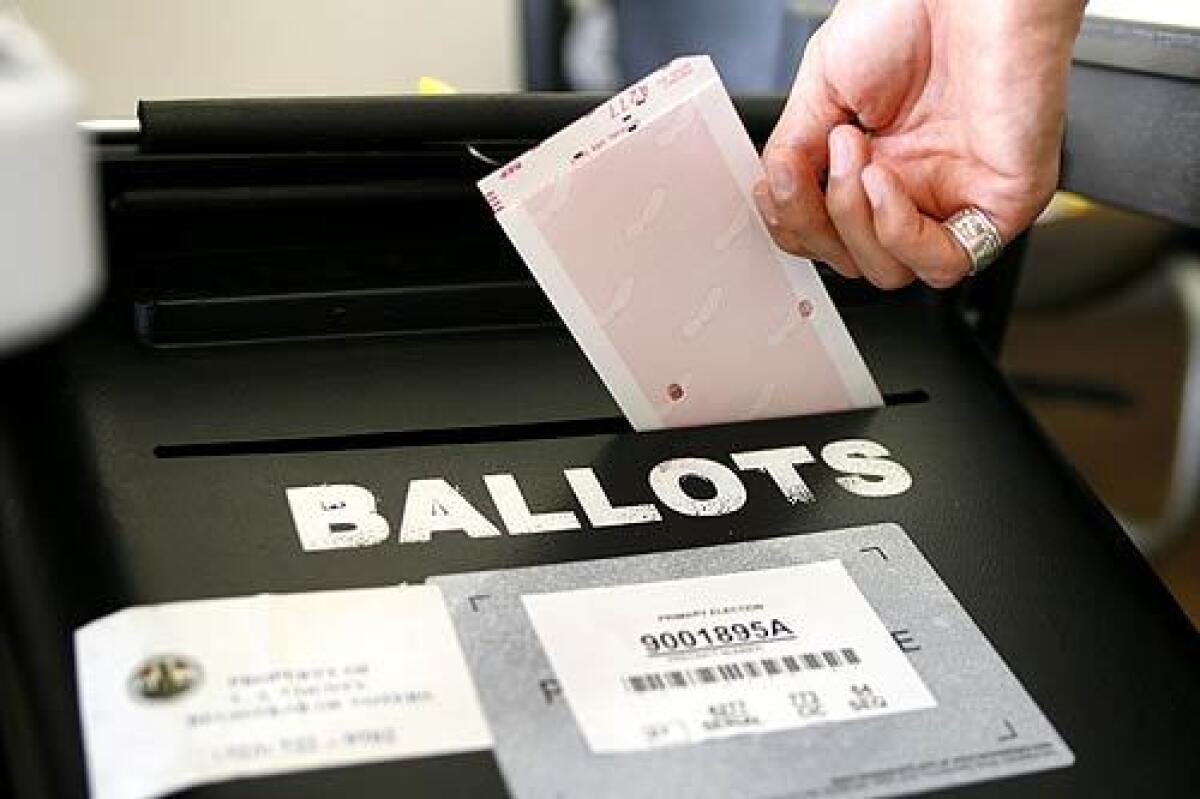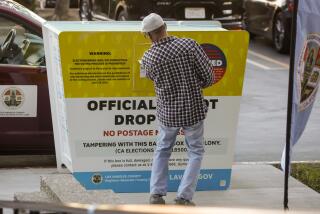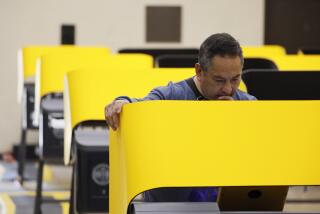Op-Ed: College students don’t turn out to vote. Here’s how to change that

College students have traditionally voted at one of the lowest rates of any group in the United States. But it doesn’t have to be that way. In the 2018 midterm election, the voting rate at U.S. colleges and universities more than doubled from the previous midterm, jumping from 19% in 2014 to 40%. That increase was 7 percentage points higher than the increase in voting rates among all Americans.
Many factors contributed to the uptick in student voting in 2018. But a key one was the engagement of a number of universities in encouraging students to vote. The U.S. Higher Education Act obligates colleges and universities to “make a good faith effort” to distribute voter registration forms. But until recently, many campuses took a minimalist approach to fulfilling that obligation, and some faculty members have even been cavalier about encouraging student voting, assigning articles about the irrationality of voting, or failing to cover the practical mechanics of voting in their classes.
Things are starting to change, however. Like a number of other universities, Harvard (where I teach) has become far more engaged in recent years in encouraging voter participation among students. In the fall of 2015, the university added a voter registration window as part of the mandatory online check-in process completed by all undergrads. It allowed interested students to access a voter registration platform, TurboVote, that walks students through the process of registering and voting in any state. In 2018, Harvard President Larry Bacow gave the incoming freshmen their “first homework assignment” during his welcome speech to them, asking those who were eligible to register and vote.
Then, leading up to the 2018 midterms, students, faculty and staff joined together in the Harvard Votes Challenge. They hosted registration drives and on-campus events aimed at boosting voter turnout. These events were nonpartisan, encouraging voting by students of every political stripe. As part of the challenge, my school, the Harvard Kennedy School, registered more than 90% of our eligible students. In the wake of these initiatives, eligible Harvard students increased their voting in presidential elections from 48% in 2012 to 58% in 2016, and in midterm elections from 22% in 2014 to 49% percent in 2018, according to data from the National Study of Learning, Voting and Engagement at Tufts University.
The Harvard story is not unique; similar efforts have been happening at other institutions around the country, at community colleges, large public universities and private institutions alike. Northwestern University, for example, used peer-to-peer contact to register 95% of its eligible students to vote. The University of Michigan tripled voter turnout from 14% in 2014 to 41% in 2018, sparked by a nonpartisan campus initiative led by the president, Mark Schlissel. He recruited 13 other leaders of universities to join him in a Big Ten voting challenge for 2018 to compete for two titles: the school with the highest percentage voter turnout (which the University of Minnesota claimed) and the school with the greatest increase in turnout (claimed by Rutgers University).
A Yale-Harvard voter challenge followed their model. Campuses have long competed on the sports fields; now they were competing for which could turn out the most voters. Within a single state, the variations among institutions is often great, suggesting that the impetus for change is not necessarily the supply of candidates who appeal to the young, but the civic cultures students, faculty and administrators help create.
In focus groups I conducted with Harvard students, I learned that they found voting difficult and complicated. Absentee voting was something they found especially hard. Ballots have to be requested in advance, and I found to my surprise that young people today don’t always know where to find stamps and mailboxes, since they’re not a part of their daily life. Faculty and staff, as well as students who’ve already gone through the process, can help first-time voters navigate the maze.
We learned in 2018 a lot about which techniques work: incorporating voter registration options and assistance into the course registration and student ID processes; providing personal assistance from a knowledgeable peer or other member of the university community; and organizing meetings and parties around voting. At the parties and gatherings, students encourage one another to make an actual plan to vote and sign up to be reminded via text message. These activities can have effects long beyond college. Because voting habits are formed early in life, those who vote as students are more likely to become lifelong voters.
The current moment is full of peril for our democracy and demands participation by all of us. We should take the opportunity to reinvigorate democracy from the bottom up, and continuing to encourage more student participation as we head into 2020 is a key part of that process.
Kathryn Sikkink is a professor of human rights policy at the Harvard Kennedy School. Her latest book is “The Hidden Face of Rights: Toward a Politics of Responsibility.”
More to Read
A cure for the common opinion
Get thought-provoking perspectives with our weekly newsletter.
You may occasionally receive promotional content from the Los Angeles Times.






